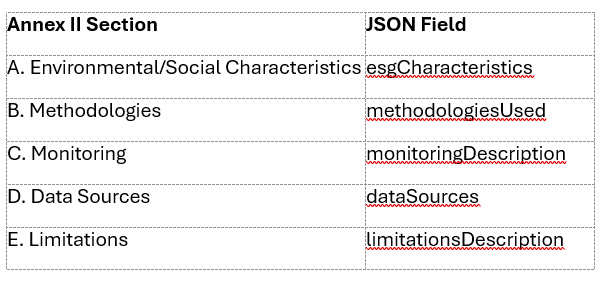
Anatomy of the CSSF SFDR JSON file: field-by-field breakdown
Delve into the intricacies of the CSSF SFDR JSON file with our comprehensive field-by-field breakdown, designed to help Luxembourg-based fund managers streamline their sustainability disclosures. Learn how to align with regulatory standards using precise data mapping for successful submissions.
As SFDR reporting becomes increasingly structured and data-driven, Luxembourg-based fund managers are now expected to submit sustainability disclosures not just in PDF format, but also via the CSSF-mandated JSON file. This machine-readable format aligns with Annexes II, III, IV and V, of the SFDR Regulatory Technical Standards (RTS), and requires precise data mapping to comply with the CSSF JSON schema.
In this article, we provide a field-by-field breakdown of the CSSF SFDR JSON file, helping middle-office teams, compliance officers, and reporting professionals understand what’s required — and how to get it right.
Overview: What is the CSSF SFDR JSON file?
The JSON file is a structured version of the SFDR RTS templates, built for digital submission through the CSSF’s eDesk platform. Each section of Annex II or V is mapped into a set of JSON objects and fields, preserving the content while enabling automated validation.
The two main file types:
- Annex II JSON: Pre-contractual disclosures for Article 8/9 funds.
- Annex V JSON: Periodic disclosures based on the fund's annual reporting.
Key Sections of the JSON File (Annex II and Annex V)
Below is a high-level breakdown of key sections with example fields:
-
General fund metadata
Purpose: Identifies the fund/sub-fund and filing context.

2. Fund & sub-fund identifiers
Purpose: Indicates the fund and sub-fund

3. Environmental /social characteristics or objectives
Purpose: Captures the product’s ESG strategy and claims.

Pro Tip: The Majority of sections in the report Maps to a section in the PDF report.
4. Principal Adverse Impacts (PAIs)
Purpose: Declares how PAIs are considered, and reports indicators.

This aligns with Table 1 of the SFDR RTS and must be consistent with your fund's declared methodology.
5. Asset allocation
Purpose: Shows the distribution of investments across categories.

6. Due diligence, engagement, and benchmarking

7. Periodic Reporting Add-ons (Annex V)
For periodic reporting, Annex V requires performance indicators:

8. Visual Elements (Graphs and Charts)
Charts in the RTS Annexes must be represented as structured data in the JSON. For example:
json
CopyEdit
"chart1": {
"labels": ["Sustainable", "Other"],
"values": [60, 40]
}
Mapping Example: Annex II to JSON

Validation: why it matters
Each CSSF JSON file is validated against a schema definition, which checks:
• Field presence
• Data types
• Logical consistency (e.g., totals = 100%)
• Syntax correctness (no trailing commas or mismatched brackets)
Failing validation will block submission in the CSSF eDesk portal.
Conclusion: Structuring for success
Understanding the CSSF SFDR JSON file field-by-field allows for:
- Efficient mapping of your RTS templates
- Accurate and compliant submission
- Improved audit trail and regulatory confidence
Investing in proper schema mapping and automation is no longer optional — it's essential for fund managers seeking to stay ahead in the world of sustainable finance transparency.